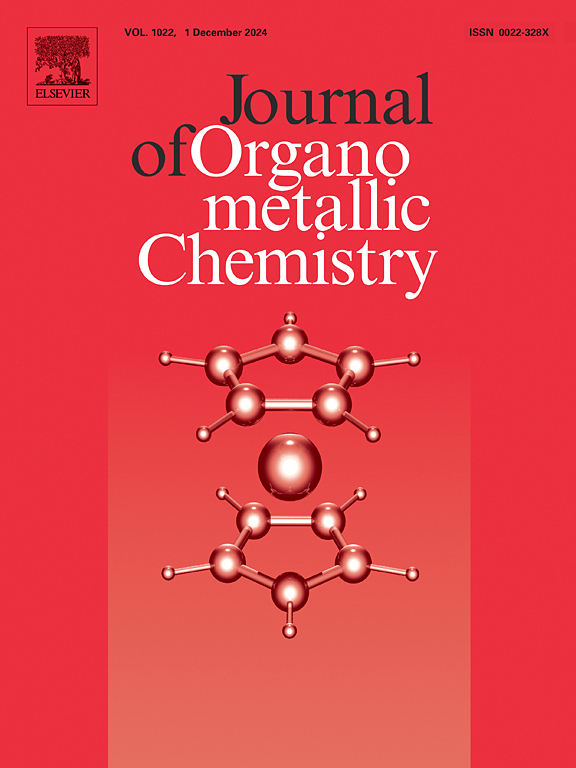超声辅助绿色合成木质素磺酸-铜纳米复合材料:在Ullmann型CN偶联反应中的应用及抗白血病作用研究
IF 2.1
3区 化学
Q3 CHEMISTRY, INORGANIC & NUCLEAR
引用次数: 0
摘要
近年来,生物源或生物启发纳米材料在不同领域,特别是在化学催化和药物治疗方面有着巨大的推动力。本研究以木质素硫酸钠(NaLS)溶液为稳定还原剂,在超声条件下设计并合成了表面修饰的CuO纳米颗粒。采用FE-SEM、EDX、元素映射、TEM、FT-IR和XRD等方法对制备的CuO@NaLS纳米材料进行了物理化学表征。随后,该材料作为纳米催化剂用于Ullmann型CN偶联反应,并在三乙胺作为添加剂碱的存在下,将苯胺、杂环胺吲哚等芳香胺与多种卤代芳烃反应。以碘和溴苯为原料,在1 ~ 2 h内合成了一系列n -芳基吲哚和苯胺,产率在90 ~ 96%之间。该材料被成功分离并连续重复使用了8次,反应性没有明显的下降。随后,为了进一步探索合成材料的生物学应用,我们利用标准的THP-1急性白血病细胞系研究了其抗白血病治疗的潜力。该试验旨在评估该材料抑制这些癌细胞增殖和存活的能力。我们用MTT法测定CuO@NaLS的细胞毒性,发现其随物质剂量的增加而增加。然而,对该材料的体内研究或动物实验仍然是一个挑战,需要未来的努力。本文章由计算机程序翻译,如有差异,请以英文原文为准。

Ultrasound assisted green synthesis of lignosulfonate-copper nanocomposite: Investigation of its application in the Ullmann type CN coupling reactions followed by study of anti-leukemia cancer effects
In recent times biogenic or bioinspired nanomaterials have tremendous impetus in different domains, particularly in chemical catalysis and medicinal therapeutics. In the current research, surface modified CuO nanoparticles were designed and green synthesized over sodium lignosulphate (NaLS) solution as stabilizing and reducing agent under ultrasonic conditions. The as prepared CuO@NaLS nanomaterial were physicochemically characterized over different methods including FE-SEM, EDX, elemental mapping, TEM, FT-IR and XRD. The material was subsequently used as nanocatalyst in the Ullmann type C![]() N coupling reactions while reacting aromatic amines like aniline and heterocyclic amine indole with diverse haloarenes in presence of triethyl amine as additive base. An array of N-aryl indoles and anilines were synthesized with a great productivity ranging between 90–96 % within 1–2 h using iodo and bromobenzenes. The material was successfully isolated and reused for 8 runs in succession without discernible deduction in reactivity. Subsequently, to further explore the biological applications of the synthesized material, its potential in anti-leukemia cancer therapy was investigated through an assay employing the standard THP-1 acute leukemia cell line. This assay aimed to evaluate the material's ability to inhibit the proliferation and survival of these cancerous cells. We used the MTT method to determine the cytotoxicity of CuO@NaLS and discovered that it increased as the material dose increased. However, in vivo study or animal experiments upon the material are still challenges, to be the future endeavor.
N coupling reactions while reacting aromatic amines like aniline and heterocyclic amine indole with diverse haloarenes in presence of triethyl amine as additive base. An array of N-aryl indoles and anilines were synthesized with a great productivity ranging between 90–96 % within 1–2 h using iodo and bromobenzenes. The material was successfully isolated and reused for 8 runs in succession without discernible deduction in reactivity. Subsequently, to further explore the biological applications of the synthesized material, its potential in anti-leukemia cancer therapy was investigated through an assay employing the standard THP-1 acute leukemia cell line. This assay aimed to evaluate the material's ability to inhibit the proliferation and survival of these cancerous cells. We used the MTT method to determine the cytotoxicity of CuO@NaLS and discovered that it increased as the material dose increased. However, in vivo study or animal experiments upon the material are still challenges, to be the future endeavor.
求助全文
通过发布文献求助,成功后即可免费获取论文全文。
去求助
来源期刊

Journal of Organometallic Chemistry
化学-无机化学与核化学
CiteScore
4.40
自引率
8.70%
发文量
221
审稿时长
36 days
期刊介绍:
The Journal of Organometallic Chemistry targets original papers dealing with theoretical aspects, structural chemistry, synthesis, physical and chemical properties (including reaction mechanisms), and practical applications of organometallic compounds.
Organometallic compounds are defined as compounds that contain metal - carbon bonds. The term metal includes all alkali and alkaline earth metals, all transition metals and the lanthanides and actinides in the Periodic Table. Metalloids including the elements in Group 13 and the heavier members of the Groups 14 - 16 are also included. The term chemistry includes syntheses, characterizations and reaction chemistry of all such compounds. Research reports based on use of organometallic complexes in bioorganometallic chemistry, medicine, material sciences, homogeneous catalysis and energy conversion are also welcome.
The scope of the journal has been enlarged to encompass important research on organometallic complexes in bioorganometallic chemistry and material sciences, and of heavier main group elements in organometallic chemistry. The journal also publishes review articles, short communications and notes.
 求助内容:
求助内容: 应助结果提醒方式:
应助结果提醒方式:


